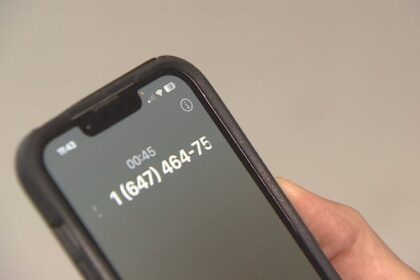British ColumbiaLocal governments and First Nations are responsible for sharing emergency notifications about wildfires, tsunamis, and other hazards. A number of those notifications can be sent through an alert system operated by the province, while others require residents to subscribe first. Some emergency managers say the system needs changes.Some emergency managers say a more provincewide system could help Kathryn Marlow · CBC News · Posted: Aug 26, 2025 8:00 AM EDT | Last Updated: 6 hours agoA text message alert from B.C.’s Alert Ready system is shown on Wednesday, Nov. 16, 2022. (Gian Paolo Mendoza/CBC)Emergency managers across B.C. have been issuing emergency alerts this summer, with notifications about wildfires and a potential tsunami. But some wish they had better tools at their disposal. Emergency alerts are the responsibility of local governments and First Nations. When there is an immediate threat to life, and there is information that could help save lives (i.e. evacuation orders), local governments can ask the provincial government to send a “broadcast intrusive” alert through B.C.’s emergency alert system. That means an alarm sounds and a short message is broadcast on television and radio, and on cellphones that are connected to the local network, in the area that is under threat. (People are likely most familiar with that system from Amber Alerts, which are sent when a child has been abducted and police have information to share about the person believed to have abducted them.)Local governments do not have the authority to send broadcast-intrusive alerts themselves. If they want to notify residents of an emergency that doesn’t meet the province’s bar of immediate threat to life (for example, July 30’s tsunami advisory), they can share messages on their website and social media and through news releases.In order to share the message more directly, local governments often contract third-party notification systems like Alertable and Voyent Alert. Through those systems, they can send push alerts through phone apps, as well as emails, text messages, and calls to landlines — but residents have to subscribe first. Alertable is one of the emergency alert systems commonly used by local governments in B.C., including the Strathcona Regional District (SRD). Residents have to sign up in order to receive alerts. (Strathcona Regional District)That presents a challenge, especially in regions where there are multiple jurisdictions. In Greater Victoria, for example, there are at least four different systems used by the 13 local governments. That’s precisely why the province should set up an overarching system, according to Shaun Koopman, the manager of emergency services with the Strathcona Regional District, based on northern Vancouver Island. He’s calling on the provincial government to contract one company to provide alert systems for both the provincial and local governments. This is Vancouver IslandHow a tsunami advisory may be a wake-up call for island emergency preparednessFor 12 hours this week, islanders and coastal B.C. residents were watching for news of a tsunami. It didn’t arrive, but it did give us a chance to figure out the difference between a “watch,” an “advisory,” and a “warning,” and whether we even get notifications. This week’s episode catches up on what we learned – including that drones can help spread the news to remote areas.He said if there was one service provider, people could simply subscribe to the one system and then opt in to receive alerts from every jurisdiction they spend time in — instead of signing up for alerts separately for the municipality they live in, the one they work in, and the others where they may spend time. It would also mean local governments and First Nations wouldn’t have to take on the cost of a notification system themselves. “It’s one default system…[to] just know that every member of the public and every community at least has that default blanket coverage,” said Koopman. Tarina Colledge, chair of the B.C. Association of Emergency Managers, said having both local governments and the province using the same alert system would also help make sure that everyone would receive urgent alerts in one fell swoop — even those who don’t watch TV or radio or aren’t in cell range. “So a broadcast intrusive alert would then replicate through for things like email, text message … a landline phone,” she said. She says that would help in rural communities and for older adults who only have landlines. It would mean that people would automatically get an alert in the way that best works for them. Earthquakes are one of the types of emergencies covered by B.C.’s emergency alert system. They’re triggered by Natural Resource Canada’s Early Earthquake Warning System. (Andrew Kurjata/CBC)But Erin Stockill, the emergency program officer for the District of Saanich in Greater Victoria, said the current system works well for her municipality, because it relies more on proximity to the existing emergency, and less on people having to intentionally subscribe. “There’s no guarantee that someone who’s subscribed is in close proximity to the hazard. So this broadcast intrusive system ensures speed and effectiveness so that the people who need to know will be made aware,” said Stockill. The B.C. Ministry of Emergency Management and Climate Readiness did not directly answer CBC’s question about whether it has considered contracting a single service provider, but did say in a statement that after each emergency event, it “reviews the event and actions taken in order to help determine where any improvements can be made.”That includes tsunamis, earthquakes, wildfires, floods or other hazards. ABOUT THE AUTHORKathryn Marlow is a reporter for CBC Victoria, and the host/producer of the podcast This is Vancouver Island. She covers stories in greater Victoria, and across the whole Vancouver Island region. You can reach her at kathryn.marlow@cbc.ca.
Is B.C.’s emergency alert system effective? It depends who you ask











